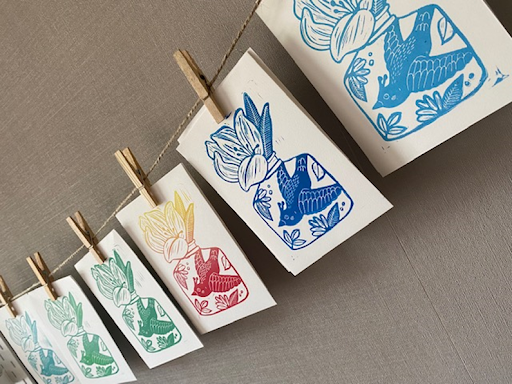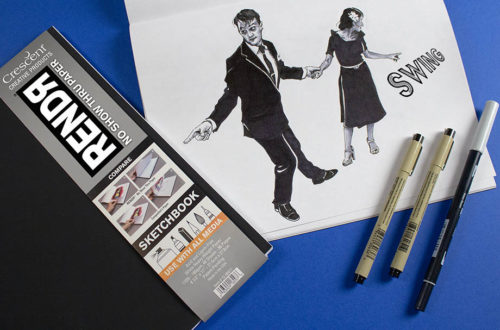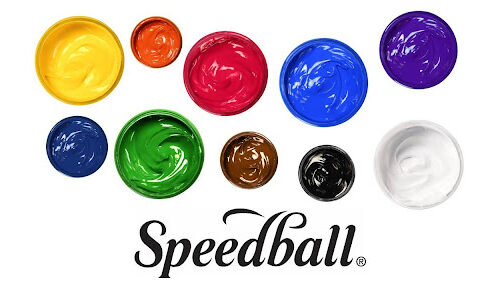I am Esther Elzinga, printmaker/stampmaker from Dordrecht, Netherlands. In my creative studio ‘Tokek’ I combine my love for printmaking and fabrics. I am married to Jan, some of you may already know him as Mr. Woodzilla. He builds the most beautiful and strong hand-printing presses in his own workshop. With 5 children, 3 cats and a studio filled with prints and presses our house is a colorful, sometimes busy but certainly creative happy place!
In this blog I’m going to explain how you can easily make a print using Speedball Speedy-Carve™ Blocks.
You will need:
· Gouges: I used Speedball Lino Cutters and Flexcut gouges. The Speedball Cutters are nice to start with. They are not expensive; they are sharp and there are different sizes (U and V shape) of blades in the red handle. Easy to store!
· Speedy-Carve™ Block: I am a big fan of this. Perfect quality. The rubber doesn’t dry out and is very easy to cut.
· I used Arnhem 1618 Printmaking Paper. Paper is really something to experiment with in printmaking. There are so many different textures, colors, and weights in printmaking paper. Buy some loose sheets of paper and experiment so you will see soon enough what works best for you.
· Block Printing Ink: I used Speedball Fabric Block Printing Ink. The advantage of this ink is that it dries quickly. After drying overnight, the prints are already dry enough to store. There are a huge number of different inks on the market. Water and oil-based. In a tube or in a jar. Ink for paper or fabric etc. Also, for the ink, test which ink suits you and your project.
· Brayer: Brayers come in different sizes, materials, and hardness. I find Speedball Soft Rubber Brayers very nice to work with. They hold the ink well and you can easily clean them after use.
· Hand Printing Tools: I personally like to use a wooden baren for printing on fabric. You can also use a wooden spoon for printing!

Optional Materials:
· A sheet of tracing paper is great for transferring the print. Tip 1: You can use a sheet of (white) baking/parchment paper! This works fine also 🙂
· Speedball has nice Bench Hook/ Inking Plates. You can safely cut your block on these plates and you can use them to roll ink on.
· An inkpad. You can use it to quickly try out your block while you are cutting.
· A black soft pen (black fineliner) and soft (graphite) pencil are also handy to have around!
Let’s get started!
To start, you need to have an idea for your block print. Inspiration can be found anywhere, in nature, in museums or just around you. If you have an idea you can start making a sketch. If you don’t want to or can’t make a sketch that is no problem, you can also use a picture from a book or from the internet as a reference.
I was asked to make something typically Dutch…but didn’t want to make a windmills or clogs print 😉 So I took tulips and delft blue as inspiration. I love cutting flowers and birds so with that in mind I started sketching. You can make a design right away on the rubber but I prefer not to do that. So hence a sketch on paper first.
The sketch in my sketchbook.


I traced the sketch with a black soft fineliner. In this way you can see better what the definite lines will be and it makes tracing easier. Make sure your sketch fits the block in terms of size. If not, you could use a copier to enlarge or reduce the size of the sketch. I find it helpful to trace around the block in my sketchbook to make sure the size and proportions are right.
This is the stage where you have to start thinking about which areas you want to cut away. In other words, do you want negative or positive surfaces and where exactly. Negative means all areas that remain and are not cut away. So these are the places where ink will appear. And positive means the areas that are cut away.
Here is an example of a stamp that has been cut into both negative and positive. Left is the negative, right is the positive.

Now lay your sheet of tracing paper (or baking paper) over the sketch and trace over with a soft pencil (2B or softer). It is helpful to secure the overlay paper with a piece of tape so it cannot slide around.

When everything has been traced, you can carefully loosen the tape again. Be careful not to go over the tracing paper with your hand because the soft pencil can easily stain.

Now turn your tracing paper over and place it on the rubber block. Gently rub, without moving the paper, with your fingers or possibly the rounded side of a spoon or a folding bone.

You will see that the print appears on the rubber without having to apply much force. If necessary, check by lifting a corner to see if the print is on it correctly. Watch out for shifting!

I darkened the image slightly with a soft pencil. So that you can see it better in the pictures. This is usually not necessary. You could also trace over the lines with a dark soft pen.

Before you start, with cutting in your block, get to know your tools well. Make a test rubber with different exercises. For example, straight lines side by side with different blades. See what the differences are. Try making dashes or dots. Make lines that go from thick to thin. Try cutting circles, etc. You will see that practice literally makes perfect.
Tip 2: If you need to cut a curve or circle; keep your hand still and move the rubber gently under your hand. This way you can steer well and get smooth lines.

And then it’s really time to put your gouge into the rubber block. I always start with the outside edge of the image myself. For this I use a V-blade.
. This way you get a clear and little deep line. Note: always cut away from yourself and don’t put your other hand in front of your knife. The gouges are very sharp! Tip #3: Speedball sells great steel shelves (Inking Plate Bench Hook) that you can put on your table. This allows you to apply force without fear of sliding off across the table. Also, you can protect your other hand behind the raised edge. Furthermore, you can use the bench hook as an inking plate. It is smooth and easy to wash!

After the outline of the image, I remove all the rubber along the outside. Not too deep because I like some movement (through stripes) around the flowers. After your test print, you can always cut away deeper if you like that better. If you want you can even cut away the whole outside edge with a hobby knife.


That’s done and now the inside. A smaller gouge works well for the details. Look at your sample piece of rubber which knife will work best.

Now you need some patience. Slowly remove each line. Better leave more rubber and remove some later than carve away too much.

Once you’ve cut everything away, it’s time for a test print.
Tip #4: Make a test print with an inkpad. This way you don’t have to use your block printing ink and rollers yet and you can check in a quick simple way where possibly something needs to be removed.
I use Speedball Fabric Block Printing Ink.
. With 6 base colors, you can easily mix any color you want and it’s just as much fun to print on fabric with it! But first a test on paper!
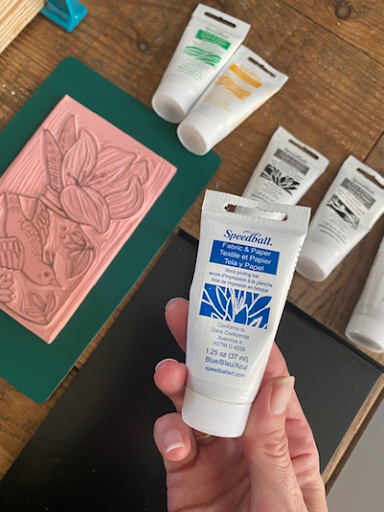
Choose or mix a color. You can use a spatula to mix the color. Put the ink at the top of your inking plate. This becomes the ‘ink reservoir’. Here you can carefully roll out some new ink when the brayer is out of ink.
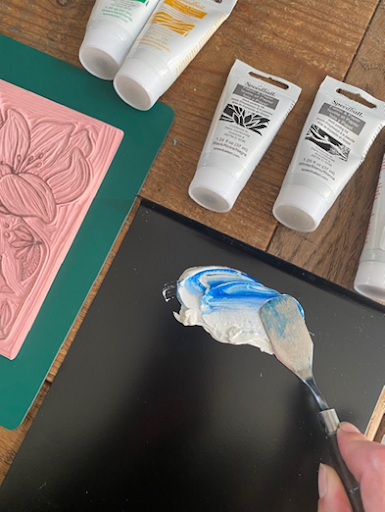
Never use too much ink on your brayer. This will definitely not be pretty! And it will cause the details to become dense with ink on your block. You probably need less ink than you expect.
Always roll a tiny bit of ink along on the brayer until it is evenly filled with ink. If your brayer looks like an orange peel, there is too much ink on it! You can carefully scrape the excess ink off the roller and put it back in the ink reservoir…. and carefully start over.

When the ink is even and not too thick on the brayer, roll the ink onto your block. Keep rolling until all the “upwards” parts have ink. Do not press too hard on the brayer. This will cause the details to fill up with ink. Move the brayer from top to bottom and from left to right, this way you can be sure that there is ink everywhere. Now put the brayer away and make sure you have no ink on your fingers before you pick up the paper.

Place the print paper on the block and gently rub the paper with your hand. This will secure the paper to the block and prevent it from moving around so easily. Use a wooden spoon or a baren to give pressure in a circular motion over the paper.

Now you can carefully pull the paper from the block! Always the most fun part of the printing process!!!

And there’s your test print!!! Maybe you’re happy with it all at once or maybe you want to make some minor changes.
I’m just removing some stripes on the left side of the block. I like a little movement but this is just too much.

The possibilities with block printing are endless. Variations in color, on different textures of paper… or fabric printing. How about a shirt with your own print on it!!!
Hopefully I was able to get you excited about block printing.
You can follow my work on instagram @studio.tokek or on my website www.Studiotokek.com


